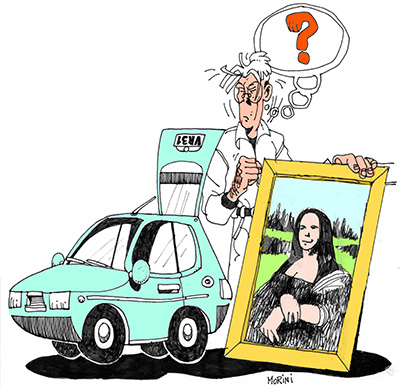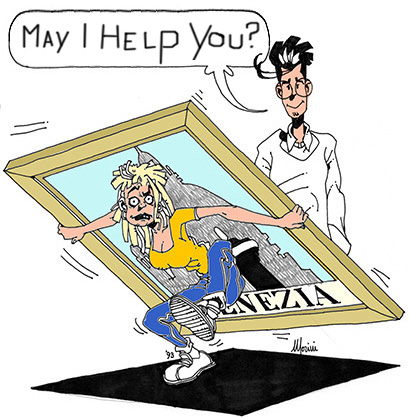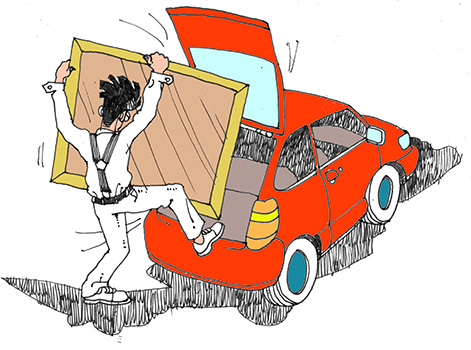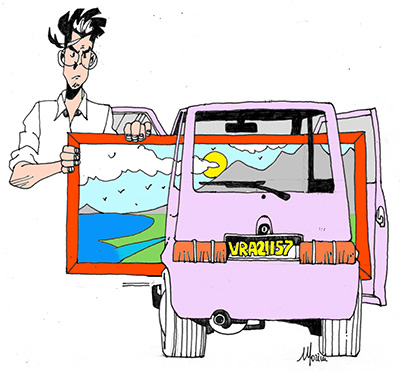Large pictures often present various problems. For example, how to strengthen the corners, how to hang them, what kind of glass to use or how to deliver them, which price to ask, etc.
Corner joints
One of the most common problems in framing “enormous” pictures is strengthening the corner joints of the frame. The weight of larger pictures can create significant tension in the joints thus reinforcement is necessary. If stapling the joint, additional staples must be stacked on top of each other. It is also a good idea to apply glue on both ends of the joint for extra support.
If the frame is thin, corners may be reinforced with steel corner squares. The squares can be attached with nails or screws. Some squares have bridges where hangers can be applied, however the two holes of the bridge must correspond exactly to those of the hanger.
Glass
Large pictures require glass 2-3 mm thicker than the 1.6/1.8 thickness used for normal frames. Framers rarely keep this type of glass in stock, thus the glass must be ordered. Thicker glass resolves the problem of fragility, however it does require a heavier frame in order to sustain the weight of the glass.
An alternative to regular glass is “plastic” glass. Plastic glass is available in various types including crilex, polyurethane, and plexiglass. They have different characteristics, yet they are all much lighter and less fragile than glass. For extremely large pictures, plastic glass is a good alternative, but keep in mind that plastic glass is easier to scratch, and is also more expensive than regular glass.
After the picture has been framed, it is important not to exert too much pressure when cleaning the glass, as it is very easy to break the sheet. To avoid this risk, rest the glass on pieces of cardboard placed on a flat plane, creating a support surface. The glass will be resting on the rebate of the frame and the central part of the support surface.
Backboards
Normal grey board can not be used as backboard because it is not available in such large sizes.
In some cases, you may piece it together but the finished product tends to look less professional, so it is better to use other materials.
Recently, the trend has been to use corrugated cardboard which is easily found in 100x140 cm sizes (Rinaldin provide also 120x160 cm size). Corrugated cardboard is light, easy to cut, and doesn’t add excessive weight. Another option, although a bit more costly, is foam board. Foam board works very well and is available in large sheets.
Thin frames
Framers should advise clients of the technical problems when using thin frames for large pictures. Some risks are that the frame will not support the weight and the glass could break, or that the glass could shift out of place.
If the picture is lifted from the centre of the top side, the frame could move and the glass could slide or pop out. To avoid this problem, securely tie the top and bottom sides with a piece of wire, so that it is fixed in the centre of the two sides. Attach a nail in the centre of the two sides, twist the wire around one of the nails, then twist the wire around the nail of the opposite side. Remember to attach the two nails before the picture process, otherwise the glass could break while hammering the nails. Then, hammer the nails while keeping the wire flat.
Another method is to use plastic strap in place of wire. The strap can be attached with a manual or pneumatic gun. The strap does not have to be elastic, but since it is applied after the picture is completed, it is necessary to be cautious not to break the glass.
Hangers
In order to hang large pictures, it is recommended to use two hangers rather than one.
Trapezoid hangers work well because they allow a greater margin of error in measuring the distance between the nails on the wail. Fixed and long hangers with several holes are ideal for heavier pictures. These types of hangers can also replace reinforcement squares because the nails are fixed on both sides of the corner.
Hooks work best when they are attached approximately 5 cm from the ends. If the hooks are too close to the centre, it will be more difficult for the customer to hang the picture, and the difference between the two nails will be amplified when the picture is hung.
Also, if the two nails are not placed towards the ends of the sides, there is always the risk that one side will shift due to the unequal weight, especially if the frame is thin. It is never recommended to use three hooks because it would require absolute nail level exactness on the wall- and when the picture is eventually hung, the weight of the picture will be distributed between the two higher nails.
Picture closing
Larger pictures can not be protected in the back by paper or cardboard because cardboard is not typically available in very large sizes, and lighter paper would surely rip during loading and unloading of the picture.
One solution to this problem is to apply moistened adhesive paper along the back border in a way that partially covers the frame and the frame support. Adhesive tape or masking tape is not recommended because the adhesive tends to dry and detach with time.
Space problems
Before accepting a very large picture, you should ask yourself, “Can I frame enormous pictures?” Not all framers can. If a framer has a small workshop, the large picture may not even fit on the workbench- among the other aspects that may make the work less profitable. In these cases, you should explain to the customer that you are not able to handle work of this size and recommend another framer with which you have a “referral” arrangement.
Another option is to accept the work, yet subcontract it to another framer who is more equipped to handle this type of work.
Price
In determining prices for large pictures, you can not apply the same guidelines used for normal pictures.
Large pictures are more expensive to frame due to the extraordinary items needed including:
These are all extra costs in which the framer must consider when calculating both an estimate or a final price, so do not hesitate to ask for a higher price! Experienced framers have learned that pictures of very large or “enormous” sizes rarely translate into good business.
When the frame is finished, after consideration of the various problems, the monetary compensation is often insufficient.
Delivery
Delivery is another inconvenience, but it is at times the biggest problem of all. Often the customer can not take the picture home because it doesn’t fit in the car.
If you have a van, large car, or even a car with a hatchback, you can deliver the picture to the customer’s home. In these cases, it is certainly acceptable to charge for delivery.
“Time is money” as the old adage says. Also, if you are equipped to deliver, you may wish to hang a sign in the store or window, offering delivery with the associated rates. If you are not equipped, you can resolve this problem simply by hiring a delivery service or courier, or renting a van.
If the customer himself is equipped to bring home the picture, it is a good idea to pay attention when customers are putting large pictures into their car.
You may notice that customers tends to treat the frame with less than “white glove” care! They may drag the frame on the ground, or lean it slanted on its corner, or even stack numerous frames on top of each other, without even thinking that the hook may ruin the frame underneath.

Perhaps the thing most bothersome is to see how the glass of the frame is placed near other objects that could break it at the first bump or jolt.
To prevent any of these occurrences, the best solution is to help customers carry large pictures to the car, while tactfully reminding them to be careful when loading and unloading the picture.

Remember also that customers who bring in rolled pictures to be framed are not always aware that the size of the framed picture will be very different, as a result, there is little thought as to how to bring the picture home.

To avoid unexpected problems that could arise at the time of pick-up, ask customers at the beginning if they are indeed equipped to bring home the finished picture.
